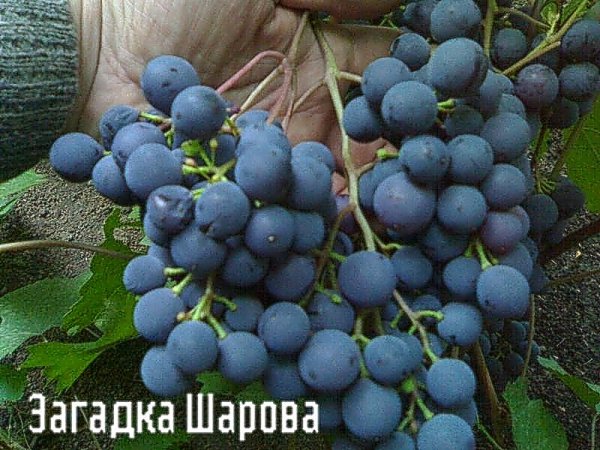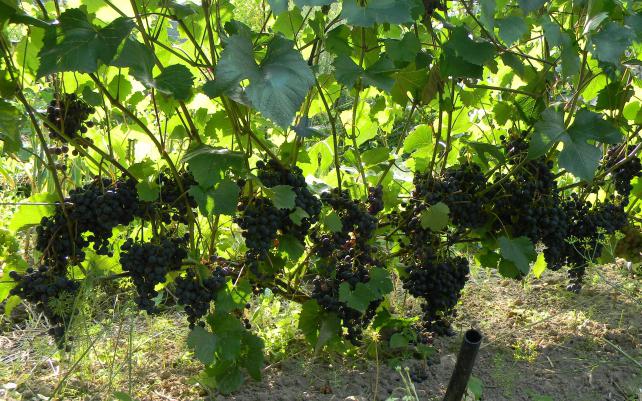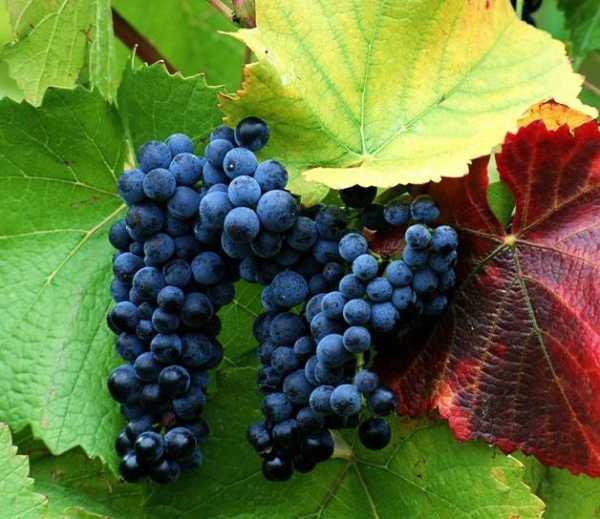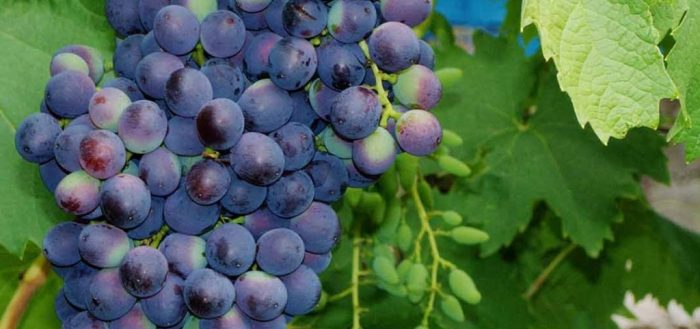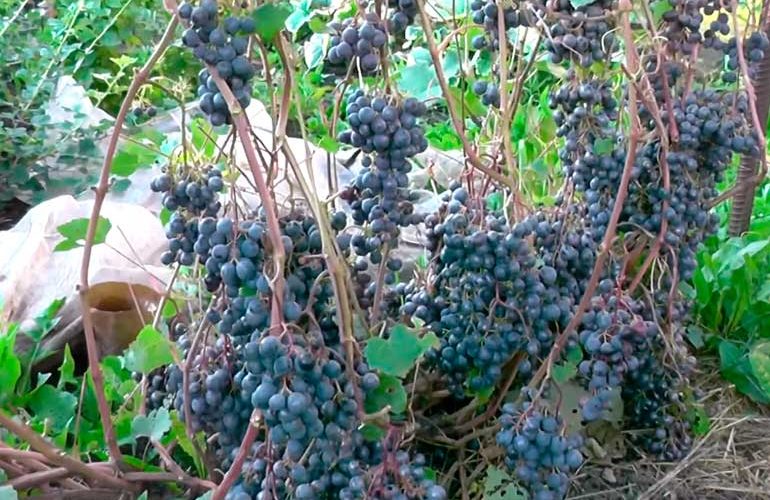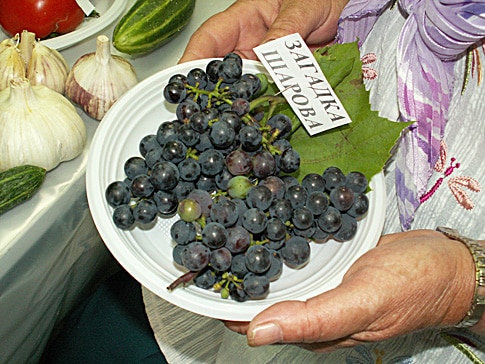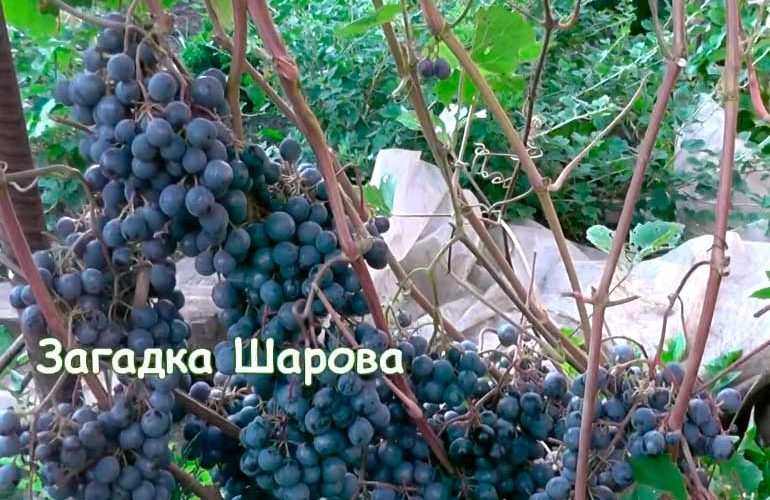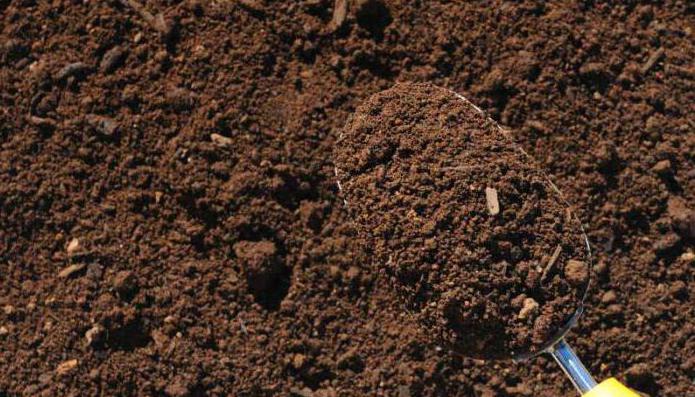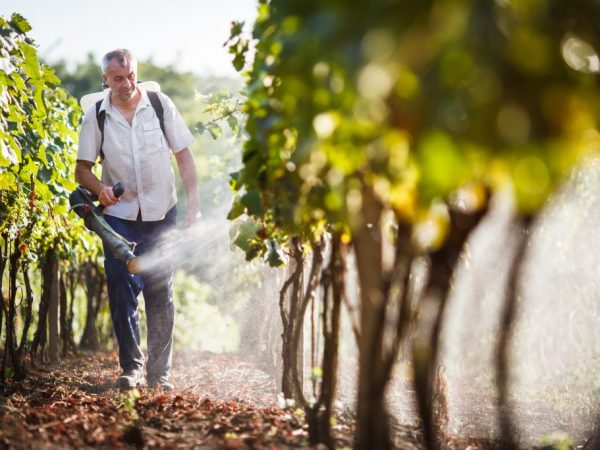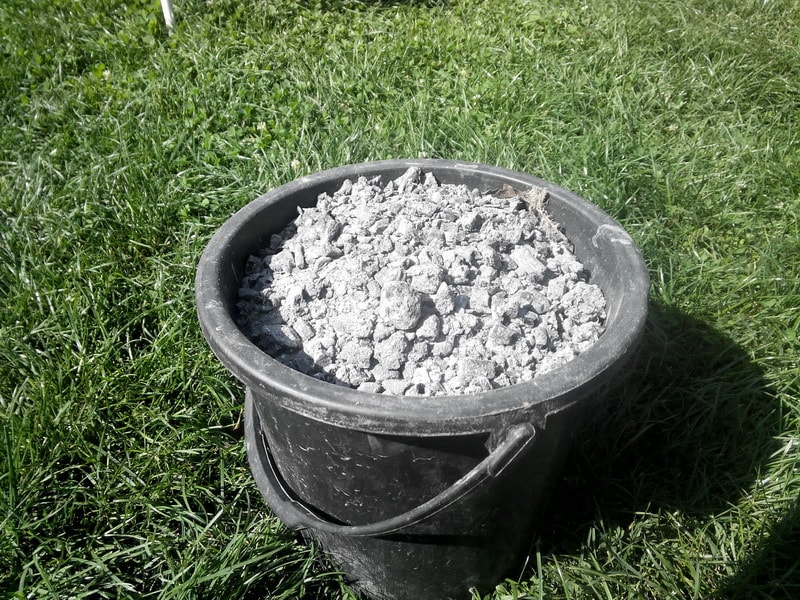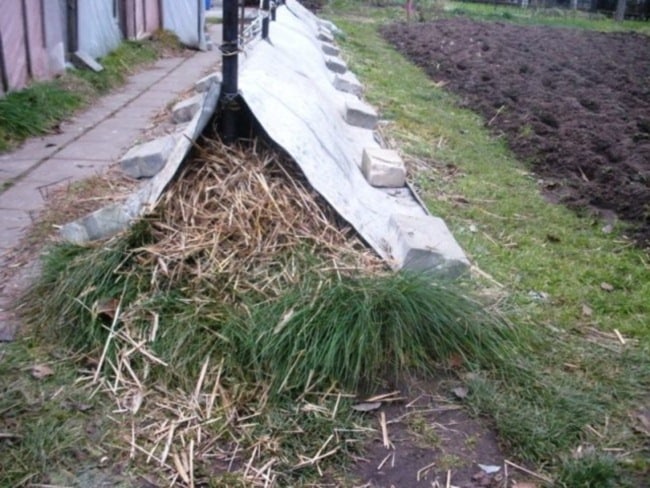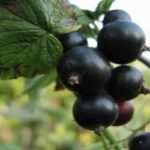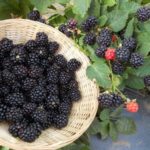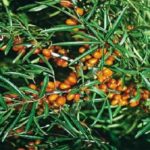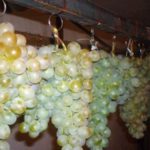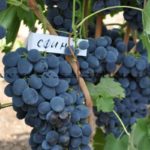When breeding the Sharov's Riddle grapes, agricultural technicians tried to create a disease-resistant hybrid intended for cultivation in different conditions that are not always favorable for the bush. The variety develops intensively, grows well and actively bears fruit. No additional conditions are needed for its pollination: the plant copes with this on its own.
- History of the species
- Description of the variety and external parameters
- Bushes and shoots
- Leaves and flowering
- Productivity and canopy size
- Appearance and taste of the berry
- Pollinability
- Reproduction methods
- Frost resistance
- Immunity to disease
- Advantages and disadvantages of the variety
- Optimal climatic growing conditions
- How to plant grapes
- Required soil composition
- Selection of seedlings
- Seating chart
- Fertilizing and watering young grapes
- Features of caring for the variety Sharov's Riddle
- Loosening the soil
- Top dressing
- Bush formation and pinching
- Preparing the vine for wintering
- Berries ripening time
- Harvest and storage
- Prevention from pests and diseases
History of the species
The secret of the name is revealed simply: the hybrid was bred by the famous amateur breeder R.F. Sharov in the USSR, who took 3 varieties as the basis for the new species: Dalnevostochny 60, Magarach 352 and Tukai. The Sharov riddle is considered a tried and tested variety; it has been grown since 1972. Rostislav Fedorovich lived in Altai, so most of the hybrids that he managed to breed and give to people were intended for cultivation in the harsh conditions of Siberia and the Urals. As a result of experiments, modern gardeners harvest sweet, tasty berries regardless of the region where they are located - both in the Moscow region and Kamchatka.
Description of the variety and external parameters
The hybrid inherited the main features and characteristics of the “progenitor” - the Dalnevostochny 60 variety. That one’s frost resistance index reaches -40 degrees, while that of the “son” is a little less - only -32.
The vitality is amazing, the bush quickly begins to send out long strong shoots, on which clusters are then densely tied.
The leaves have a classic 5-lobed shape, small and neat, with a rich green hue. The plant is bisexual; both male and female flowers ripen on it. On each shoot, 2-3 inflorescences ripen, the cluster is medium, weighing up to 300 grams (less often up to half a kilogram). The berry is dark blue, close to black in color, spherical, up to 3 grams.
The taste is delicate, with a well-balanced sugar content, slightly reminiscent of garden berries.Sharov's riddle does not pea, ripens in 110 days, hangs on the vine for a long time without damaging the fruit, and tolerates transportation well.
Bushes and shoots
The bush is large in size, with strong, but not thick, shoots (up to 3 meters long). The clusters are branched or winged, medium-sized. It has been experimentally proven that the Riddle favorably accepts standardless shaping using the multi-sleeve method and tolerates pruning. Even the fact that the vine does not fully ripen is perceived as an advantage: in the fall, everything unnecessary is removed, including unripe berries. The trimmed bush provides shelter before the winter season and tolerates cold well.
Leaves and flowering
The leaf of the variety has a regular shape with 5 petals, it is bright green, not pubescent, and smooth. Fruiting of the shoots occurs quickly, 2-3 flowers bloom on each. The grape is bisexual; both female and male inflorescences ripen. There will be no problems with pollination; there is no need to specially plant special plants near the bush for this.
Productivity and canopy size
Sharov’s riddle maintains a stable harvest of ripe, uniformly sized berries. The clusters cannot be called large, but they have a regular, cone-shaped shape. The usual weight of a brush is 300 grams, there are specimens of 500 and even 600. This depends on the growing conditions: in a warm climate the bush bears fruit better, and the crowns grow larger.
The declared yield is confirmed by the fact that a 6-year-old bush with 10-12 shoots produces up to 10 kilograms of grapes. Experts say that berries that are not picked in time become sweeter, and their taste becomes softer and more complete. Riddle fruits are stored in standard boxes before transportation or preservation - they easily tolerate such procedures. Berries can easily lie in a container for up to 3 months.
Appearance and taste of the berry
The berry is not the largest, has a clearly defined round shape, the color is blue almost to black (when ripe). The location in the crowns is of medium density, the shape of the brush is a cone smoothly tapering towards the bottom. The core is juicy and sweet. The peel is dense, but not hard, and the taste is almost undetectable. The top is covered with a light waxy coating.
There are 2-3 seeds inside the pulp, the sugar content is up to 22%. The weight of the berry is about 3 grams, it almost does not become smaller as the bush ages.
Pollinability
Sharov's riddle does not need additional pollination, and copes well on its own: thanks to its bisexual flowers, the variety fertilizes itself.
Reproduction methods
The variety is propagated by cuttings planted in the ground, or used as a rootstock for other types of grapes. In this case, a new hybrid with stable characteristics is obtained.
Frost resistance
The species is not afraid of the cold. He inherited such characteristics from his progenitor, the Dalnevostochny 60 variety, known for its hardiness. The riddle calmly tolerates frost down to -32 (34) degrees. In warm areas it is not covered for the winter; this is not a mandatory measure.
Immunity to disease
Unfortunately, the variety is sensitive to standard grape diseases, such as fungi and downy mildew. To successfully combat diseases, preventive maintenance is carried out, spraying with chemicals, as well as pre-winter pruning of damaged branches and leaves.
Advantages and disadvantages of the variety
Sharov's riddle lives up to its ambiguous name - it contains both advantages and disadvantages. The grapes are productive, tasty, sweet, early ripening and frost-resistant. The variety grows wherever there is soil, enough heat and sun - this is a clear plus.
The creator of the hybrid has done a tremendous amount of work to preserve and enhance the qualities of the ancestors and obtain a universal variety. And he succeeded. Disadvantages include weak immunity to diseases - fungal and mildew.
Optimal climatic growing conditions
The grapes were bred in the Altai region, where winter temperatures drop below 20 degrees below zero, so the spread of growing zones is quite wide. Sharov's mystery grows in the Middle Zone, in the cold climate of the Urals and Siberia; there are known cases of cultivation in extreme conditions of the Far East (in greenhouses).
In the southern regions, the combination of light and heat is more preferable for berries - there they ripen faster and better. The gardener's task is to provide the bush with the necessary planting site, sun, fertilizer and time for the grapes to ripen (110 days).
How to plant grapes
To plant cuttings, a classic scheme is used: in a selected place protected from drafts, it is necessary to dig a shallow trench (for row planting) or a hole (for single planting). A prerequisite is good drainage. To do this, large stones, gravel, and broken bricks are placed at the bottom.
You can use pieces of perforated tubes buried vertically or plastic bottles: they will supply the nutrient mixture and water for irrigation.
Required soil composition
Riddle, like other varieties, is sensitive not to the composition of the soil itself, the presence of minerals and nutrients in it, but to the fraction. Heavy, clayey soils with stagnant water are absolutely not suitable. The initial dose of fertilizer is applied during planting, when a soil mixture is created from humus and soil. The use of fresh humus is not allowed; it can burn the roots of the seedling.
Selection of seedlings
Due to the good viability of the variety, there are no special restrictions on the choice of seedling: it can be one or two years old, but the main thing is that it is healthy and not affected by pests and diseases. Propagation by cuttings is allowed, but the first option is preferable.
Seating chart
When planting seedlings, the standard scheme is followed: the distance between them is up to 3 meters, away from tall, shading plants. The bush is immersed deeply in the ground, leaving a couple of buds above the surface. When choosing a location, you need to meet 2 conditions: plenty of sun and no drafts.
Fertilizing and watering young grapes
The riddle is unpretentious: all the necessary substances are laid when planting the seedling. A developed root system allows you to find the elements required for bush growth in the soil. To evenly distribute the load on the fragile stem, shoots are removed during the first year, leaving one strong one. Such radical pruning allows you to strengthen the plant and strengthen it.
Watering is carried out regularly, but without excessive fanaticism, so as not to soak the roots.
Features of caring for the variety Sharov's Riddle
Since the bush develops quickly and produces many shoots, you will need to ensure that they do not create a shadow or interfere with the growth of the vine.
Be sure to lift and tie branches to posts or wires, which grow up to 4 meters during the season.
In a humid climate, to ensure proper ventilation, remove excessively thick foliage from the bush. For prevention and when identifying traces of pests and diseases, they are treated with chemicals Omite, Probrand or Nitrafen. To avoid mildew, it is enough to trim growing stepsons in a timely manner.
When the bunches ripen, they are additionally stimulated by spraying with preparations containing colloidal sulfur and potassium permanganate.It is recommended, despite the obvious frost resistance, to remove the vines from the suspensions for the winter, trim the bush, lay it on the ground and cover it with soil, compost, or snow.
Loosening the soil
To ensure breathability, and for the purpose of prevention against pest larvae hiding in the soil, loosening of the root zone is used. It can be combined with fertilizing with organic matter or minerals - this way the substances will reach their destination faster.
Top dressing
The grapes are unpretentious, but they will accept any care with gratitude, pouring juice into the ripe, heavy bunches. Feeding consists of adding a couple of buckets of humus under the bush - not often, once every few years. Universal fertilizer is simple wood ash, which is suitable for all varieties.
Bush formation and pinching
Due to the abundant growth of shoots, the bush needs pruning, sometimes almost radical. It is especially important to do this in the very first year of plant growth, so as not to overload the weak root system and stem. Subsequently, when the plant begins to bear fruit, you can begin to form the sleeves, directing them as necessary. Pinching is not practiced on Riddle, he develops quite well without it.
Preparing the vine for wintering
General preparation comes down to trimming branches, especially old ones damaged by pests and diseases, to a minimum. The vines are removed from the supports, bent to the ground, and wrapped. For the southern regions, shelter is practically not used; in the Middle Zone and cold regions it is mandatory. The vine laid on the ground is covered with earth, mulch, and after precipitation - with snow.
Berries ripening time
The berries ripen 110 days after bud set; in warm, favorable conditions this can happen earlier.When grown in a greenhouse, this period can be reduced by 20-30 days. The taste improves significantly as it ripens. The riddle allows for some delay in collection, this will only benefit the bouquet, becoming fuller and sweeter.
Harvest and storage
The variety bears up to 10 kilograms of ripe fruits per bush; thanks to the dense peel, the clusters are well stored. According to some reports, Sharov’s Riddle can lie for up to 3 months after collection without any changes in taste or appearance.
Prevention from pests and diseases
The grapes are sensitive to the main disease of all varieties - mildew. For prevention, pruning and removal of damaged fragments are carried out. The bush is treated with fungicidal compounds (Bordeaux mixture), Omite preparations and the like. Spraying is used not only at the first signs of disease or damage, but also for prevention.

